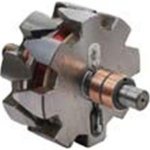shotty
Active member
- 211
- 56
- 28
- Location
- Northern VA :(
As you may know, the alternators on our trucks (AC Delco 27SI units) have an RPM output signal, which on GEN 1 is hooked up to a buffer circuit and then output to the STE/ICE diagnostic connector under the dash. So far I've been unable to get a useable signal from pin c on the diagnostic connector even with two different tach buffer boards. I'm going to try a few more boards before I hook a scope up to it to see what's going on with that signal. In the meantime...
The R terminal on the alternators is the AC output of a single phase from the alternator windings. Using the formula provide from this AC Delco document ( RPM * Ratio / Generator Factor = R terminal frequency) we can work out the RPM of the engine from the frequency on the R terminal. But first, what is the Generator Factor? There's some fancy math that goes along with the number of poles in the alternator and the rotating field, blah blah blah. For our trucks, the Generator Factor is 7.5. That's all you need to know, lets just leave it at that.
Alright, but what's the pulley ratio?
I tried searching high and low for the pulley ratio information, to no avail. So I did the next best thing: I hit the road with a GPS and my frequency counter. At 53 MPH (55 indicated on the speedometer) with my 32.8" tires, 4.56 gears, and a 1.00 transmission ratio my engine was spinning at 2476 RPM. I logged 1084 Hz on my meter. Rearranging the formula and solving for Ratio gave me 3.287. At 55 MPH on the GPS, i got 3.270 for a ratio. If it wasn't the middle of the night I could take some readings at different speeds, but I'm almost positive that the ratio is about 3.275, so that's what I'm going with.
Now that that's out of the way... Everything but the M1010 should idle at 625 RPM when warm, and 800 RPM when cold (or when the cold advance and fast idle solenoid are engaged.) This works out to 274 Hz on the R terminal when warm and 349 Hz when cold.
Just hook up your meter to the R terminal, which is the single post terminal where the connector just presses on and the rubber boot holds it in place. On GEN 1 there's a brown wire going to it. On GEN 2 it's not connected, so it will just be a bare post. Then you just adjust your idle speed until you get the right reading on your frequency meter. Easy peasy!
RPM = R hz * 7.5 / 3.275
R hz = RPM * 3.275 / 7.25
Pulley Ratio = R Hz * 7.5 / RPM
The R terminal on the alternators is the AC output of a single phase from the alternator windings. Using the formula provide from this AC Delco document ( RPM * Ratio / Generator Factor = R terminal frequency) we can work out the RPM of the engine from the frequency on the R terminal. But first, what is the Generator Factor? There's some fancy math that goes along with the number of poles in the alternator and the rotating field, blah blah blah. For our trucks, the Generator Factor is 7.5. That's all you need to know, lets just leave it at that.
Alright, but what's the pulley ratio?
I tried searching high and low for the pulley ratio information, to no avail. So I did the next best thing: I hit the road with a GPS and my frequency counter. At 53 MPH (55 indicated on the speedometer) with my 32.8" tires, 4.56 gears, and a 1.00 transmission ratio my engine was spinning at 2476 RPM. I logged 1084 Hz on my meter. Rearranging the formula and solving for Ratio gave me 3.287. At 55 MPH on the GPS, i got 3.270 for a ratio. If it wasn't the middle of the night I could take some readings at different speeds, but I'm almost positive that the ratio is about 3.275, so that's what I'm going with.
Now that that's out of the way... Everything but the M1010 should idle at 625 RPM when warm, and 800 RPM when cold (or when the cold advance and fast idle solenoid are engaged.) This works out to 274 Hz on the R terminal when warm and 349 Hz when cold.
Just hook up your meter to the R terminal, which is the single post terminal where the connector just presses on and the rubber boot holds it in place. On GEN 1 there's a brown wire going to it. On GEN 2 it's not connected, so it will just be a bare post. Then you just adjust your idle speed until you get the right reading on your frequency meter. Easy peasy!
RPM = R hz * 7.5 / 3.275
R hz = RPM * 3.275 / 7.25
Pulley Ratio = R Hz * 7.5 / RPM




 ):
):